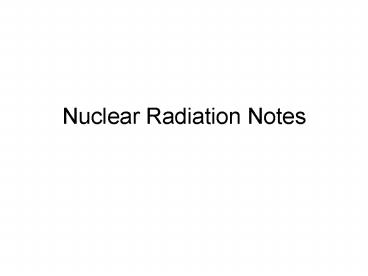Nuclear Radiation Notes - PowerPoint PPT Presentation
1 / 29
Title:
Nuclear Radiation Notes
Description:
Nuclear Radiation Notes Nuclear Radiation Notes Nuclei are unstable when they have low amounts of binding energy. When they are unstable, they are more likely to ... – PowerPoint PPT presentation
Number of Views:69
Avg rating:3.0/5.0
Title: Nuclear Radiation Notes
1
Nuclear Radiation Notes
2
Nuclear Radiation Notes
- Nuclei are unstable when they have low amounts of
binding energy. - When they are unstable, they are more likely to
break into pieces.
3
Nuclear Radiation Notes
- Nuclear reactions happen when a change occurs in
the nucleus. - Nuclear Fission is when the nucleus breaks apart
in some way - Nuclear Fusion is when particles combine in some
way
4
Nuclear Radiation Notes
- There are many different types of radiation
- 1. Alpha particle emission--a nucleus could lose
an alpha particle, which is essentially the same
thing as the nucleus of a helium atom. An alpha
particle has two protons and two neutrons, but no
electrons (so it has a 2 charge). This is a
type of fission.
5
Nuclear Radiation Notes
- A nucleus will tend to undergo alpha particle
emission if it is too heavy or it has a low
neutron-proton ratio. After alpha particle
emission, the resulting nucleus will have a
higher N/P ratio, and will be smaller.
6
Nuclear Radiation Notes
- 2. Beta particle emission--a beta particle is
just like a high speed electron. It has
relatively no mass, and has a charge of -1. A
nucleus will undergo beta particle emission if it
has too high of a N/P ratio, and therefore the
resulting nucleus will have a lower ratio. This
is also a type of fission.
7
- Wait! How can an electron come out of a nucleus,
which only contains protons and neutrons?
8
Nuclear Radiation Notes
- This is what you can visualize in your head for
how the electron can be emitted from a neutron. - See what happens to the neutron after the
electron (beta-part.) leaves
http//niels.christoffersen.person.emu.dk/natpr/fy
sanimat/beta.htm
9
(No Transcript)
10
Nuclear Radiation Notes
- 3. Gamma ray emission--a gamma ray is a
high-energy (high frequency/short wavelength)
light wave. - It has no mass and no charge, and only is emitted
at the same time as either alpha or beta
particles. - This is a type of fission
11
Nuclear Radiation Notes
- Other less common forms of radiation
- 4. Positron emission--A positron is essentially
the opposite of an electron. It has relatively
no mass, but has a charge of 1. Also a type of
fission.
12
Nuclear Radiation Notes
- When a positron leaves a nucleus, what is
happening is that a proton is losing its charge,
and therefore turns into a neutron. Positrons
will be released from a nucleus if the N/P ratio
is too low.
13
Nuclear Radiation Notes
- 5. Electron Capture--this is a process where an
electron loses its energy that keeps it in an
energy level, and gets pulled into the nucleus.
This is a type of fusion.
14
Nuclear Radiation Notes
- When this happens, the negative charge of the
electron cancels out the positive charge of a
proton, and the proton is turned into a neutron.
- This has the same effect upon the nucleus as
Positron Emission (raises the N/P ratio).
15
(No Transcript)
16
Nuclear Radiation Notes
- How do we describe these radioactive occurrences
using equations? - First we need to be able to describe nuclei
- Uranium with an atomic number of 92 and a
atomic weight of 238
17
Nuclear Radiation Notes
- Therefore, an alpha particle is
- or
18
Nuclear Radiation Notes
- A Beta particle can be described as
- A gamma ray is written simply as
- A positron is written as
19
Nuclear Radiation Notes
- A nuclear equation has a direction
- The arrow signifies which particles existed
before the change (reactants) and which ones were
present after the change occurred (products)
20
Nuclear Radiation Notes
- In a nuclear reaction, the identity of the
elements can change, but the total mass and
amount of charge must stay the same. To ensure
that our equation shows this, we must balance the
equation - Try example on page 869.
21
Nuclear Radiation Notes
- Any single naturally-occurring nuclear reaction
will have a specific rate that it happens. - This rate is measured with a half-life, which
is the amount of time that it would take for half
of a sample of radioactive material to decay
naturally. - The time it would require for a half-life to
elapse can be calculated with the following
equation N No(1/2)n (see pg. 871)
22
Nuclear Radiation Notes
- Although radioactive decay (nuclear fission)
happens naturally to unstable nuclei, it can also
be done artificially (in labs).
23
Nuclear Radiation Notes
- This is called nuclear bombardment, when a
particle is put in a collision with another
particle, encouraging one or both of them to
break apart or stick together.
24
Nuclear Radiation Notes
- Oftentimes a nuclear fission reaction will cause
a chain reaction with many final products being
generated by many separate fission reactions
25
Nuclear Radiation Notes
- This is how most controlled (power plants)
fission reactions occur - as well as uncontrolled fission reactions
(nuclear explosions)
26
Nuclear Radiation Notes
- The opposite of nuclear fission is nuclear
fusion. This is the process where two particles
combine to form one nucleus. This will only
occur if there is enough energy (heat) and is
common on the sun, for instance.
27
Nuclear Stability Notes
28
Nuclear Radiation Notes
- Most scientists believe that all known elements
have arisen from some type of nuclear fusion
(mostly in stars).
29
Nuclear Radiation Notes
- Every element above Uranium (92) has been
created by humans using some type of nuclear
fusion through bombardment (see pg. 625).































